BRIEF DESCRIPTIONS OF BAGUAZHANG CLASSICS
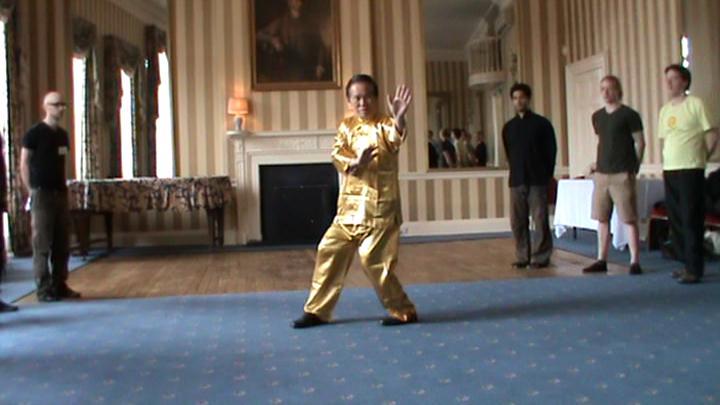
Grandmaster Wong demonstrating Baguazhang Circle Walking
Question
As mentioned in the History & Philosophy of Baguazhang Circle Walking, Sigung used a variety of sources for researching the art in his preparation for the course. Could Sigung give a few words on which sources he found the most useful and what sort of misinformation about Baguazhang exists?
Frederick Chu
Answer
Unlike Shaolin Kungfu, there are not many classics about Baguazhang. The following are the classics I used, all in Chinese and listed in the order of importance in the amount of material derived for use in the Baguazhang course at UK Summer Camp 2012. Some of them are modern publication based on classical material. The translation of the authors' names is based on Cantonese pronunciation.
- True Transmission of Baguazhang by Sun Sek Fong
- Study of Bagauzhang by Sun Lu Tang
- Secret Classic of Baguazhang edited by Lau Heng Hon
- Illustrated Explanation of Bagazhang by Yim Tak Wah
- Internal School of Baguazhang Ngai Cheng Woh
- Bagauzhang and Baguazhang Combat edited by Chang Fen Poi, Chun Yu Choong, Loh Hoong Shun
- Specific Techniques of Bagua by Cheong Hoe Chun and Fei Sek Weng
However, the relative lack of classical source is compensated by the abundance of internet material, some of which is very useful but much is mediocre and a few is misleading.
Here is a brief description of the Chinese sources.
True Transmission of Baguazhang describes the eight "mother palms", some combat applications and Baguazhang weapons like the sword, the exotic drake-duck spade, the crescent-moon spear, the Guan Dao and the spear. It emphasizes moral values, discusses internal and external, soft and hard aspects, and distinguishes between low-level practitioners and high-level practitioners. Low-level practitioners merely perform patterns, whereas high-level practitioners understand their principles.
Some basic principles are mentioned as follows.
Beginners should move with small steps, hooking the foot in each step. Each step must be sure-footed so that the body will not be shaky. Start slowly, gradually become fast. All movements should be smooth and fluid.
There are three stages in circle walking. At the first stage, movements are large and the posture is high. At the intermediate stage, practitioners should lower their posture. At the third stage, the posture is low and movements small and fast.
This classic pays much attention to footwork, affirming the saying that "30% of victory lies in the hands, 70% lies in the feet." It also mentions that many kicking techniques are hidden.
There is one significant difference between the advice given here and our practice. Here, it is advised that breathing in and out is through the nose with the mouth close. But we breathe in through the nose and breathe out through the mouth. At an advanced stage, we do not worry about the breathing.
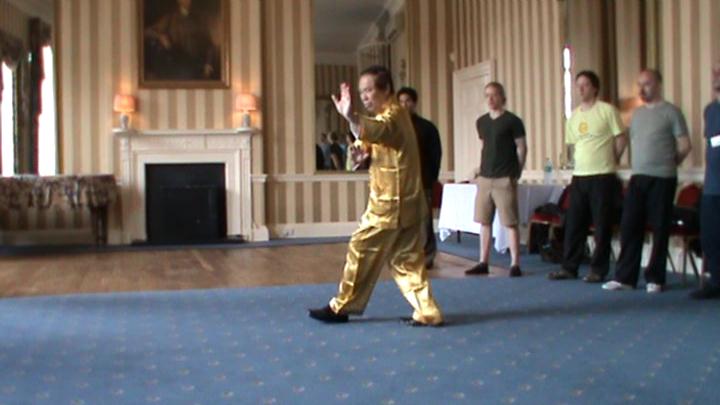
Grandmaster Wong demonstrating Baguazhang Circle Walking
The classic explains how One-Energy transforms to Two-Aspects, then to Four-Forms, which are philosophical description of how the eight "mother palms" are performed. Practitioners begin with the Wuji Stance and are in tune with the Cosmos, described as One-Energy. They move to the typical Baguazhang pattern, "Green Dragon Tests Claw", turning the hands in one direction and rotating the waist in another direction, described as Two-Aspects. Then they thread their hands up and down, and separate them on two sides, as at the start of Baguazhang circle walking, described as Four-Forms.
The eight mother-palms at various positions of the octagon structure are characterized as lion, unicorn, snake, cockerel, dragon, bear, phoenix and monkey.
It is worthy of note that the classic mentions that these animal-forms are performed at the various gua or trigrams, or various positions in the octagon structure, and not that the various trigrams symbolize these animal-forms. Due to linguistic factors, this distinction is not clearly made in Chinese.
In fact, in Chinese a literal translation of the relevant description is as follows:
Qian is the head, kun is the stomach, zhen is the feet, xun is the hips, kan is the ears, li is the eyes, gen is hands, dui is the mouth.
Qian, kun, zhen, xun, kan, li, gen and dui are the gua or trigrams which form the octagon, or Bagua, from which the term Baguazhang derives.
The classic goes on to say that in kungfu, in literal translation, qian is lion, kun is unicorn, zhen is dragon, xun is phoenix, kan is snake, li is crane, gen is bear, and dui is monkey.
What is meant here is that at the position in an octagon known as qian, the lion form is performed, and at kun the unicorn form, etc. It does not mean qian is a lion or represents a lion, as many people interpret it to be.
The practice of linking some aspects to some philosophical terms is not uncommon in kungfu culture. For example, in Xingyiquan the five elemental fists of pi-quan (literally chopping fist, figuratively thrust palm), zuan-quan (spiral fist), beng-quan (crushing fist), pao-quan (cannon fist) and heng-quan (literally diagonal fist, figuratively horizontal chop) are related to the five elemental processes of metal, water, wood, fire and earth.
But I do not see much meaning in the relationship, or I may not have learnt its hidden meaning yet.
I suspect, for example, that because the technique, which is thrusting a palm out, is called pi-quam, literally meaning chopping fist, and chopping is related to an axe chopping, and an axe is made of metal, pi-quan is said to relate to the elemental process of metal. But we could also explain that as the movement of a palm thrust is like water, this technique should be related to the process of water.
In the Five Elemental Fists of some Hoong Ka schools, for example, the five patterns "Cross-Road Separate Gold", "Throw Ball in Waves", "Clamp Wood Fist", "Eight-Tenth Arrow Punch" and "Thousand Tons to Ground" are related to the five elemental processes of metal, water, wood, fire and earth.
Either I am ignorant of its deeper meaning or some masters forced relationship between patterns and the elemental processes. Except for the last pattern, "Thousand Tons to Ground", which can be justified to relate to the elemental process of earth as the movement of the technique is downwards, which is represented by the earth process, I do not find much significance in the relationship in the other patterns.
Following this principle of relationship due to its process, the pattern, "Throw Ball in Waves", despite its name, should be related to fire as the movement of the technique is upward, which is represented by the fire process.
Indeed, masters commenting on the relationship generally say that because the pattern is called "Cross-Road Separate Gold", it is related to metal, and because the pattern is called "Clamp Wood Fist", it is related to wood. "Clamp Wood Fist" is also named "Close Iron Gate". Can we then relate the same pattern to metal because of its name?
Returning to "Study of Baguazhang", Sun Lu Tang concludes the classic with a brief discussion of the unity of pre-natal energy and post-natal energy, and the returning of the spirit to the Great Void.
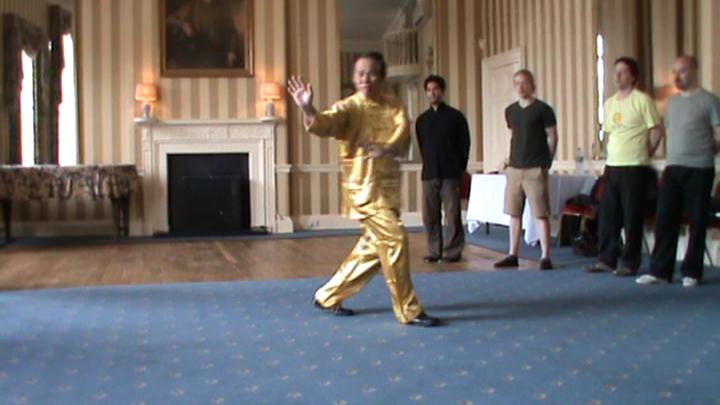
Grandmaster Wong demonstrating Baguazhang Circle Walking
This "Secret Classic of Baguazhang" is very rich. The following are just some random examples.
Regarding philosophy, the classic lists "three harms" which should be avoided as follows:
- Muscular strength
- Angry chi
- Lifted chest, sunken abdomen
It is interesting to note that "lifted chest, sunken abdomen", which is taboo in internal arts, is encouraged in Shaolin Kungfu, especially those who practice external forms. Tying a sash around the waist is an example. Practitioners take a deep breath resulting in raising their chest and sinking their abdomen, then tie a sash tightly round their waist to keep the chest lifted and abdomen sunk.
As lungs are regarded as organs for energy, this enlarging of the chest cavity gives practitioners strength and vitality, which is proven true in real life. Internal martial artists do not tie a sash as Shaolin practitioners do. They relax their chest and let chi sink to their dan tian.
The classic mentions that the "eight trigrams" or bagua from which the name Baguazhang derives, are represented in the body as follows:
- Qian is represented by shoulders, elbows and wrists, symbolized by the three unbroken lines of quan.
- Kun is represented by hips, knees, feet, symbolized by the three broken lines of kun.
- Li is represented by the sternum, symbolized by the broken middle line of li.
- Kun is represented by chi-filled abdomen, symbolized by the unbroken middle line of kun.
- Zhen is represented by eyes looking horizontally, symbolized by the two broken upper lines of zhen.
- Gen is represented by head uplifted, symbolized by the two unbroken upper lines of gen.
- Dui is represented by gently closing the mouth with the tongue placed upward at the palate, symbolized by the broken top line of dui.
- Xun is represented by lifting up the anus, symbolized as the broken bottom line of xun.
Here is an example of either I fail to see the deeper meaning of the relationship or past masters forcing relationship between the eight trigrams and bodily parts. One could also reasonably argue that qian should be represented by the head as it is the top-most of our body and qian symbolizes heaven.
The classic is very rich in songs and secret formulae. The following is an example on the three external harmonies of feet, body and hands.
-
Techniques and footwork must be co-ordinated
When hand arrives but feet wrong, force is insufficient
When hand and feet arrive but the waist is lacking
Going becomes slow and returning becomes deficient
Illustrated Explanation of Bagazhang consists of pictures showing 64 sequences of Bagauzhanng combat applications with brief descriptions. The first sequence, Thrust Palm, is similar to the first few techniques of our first combat sequence in Swimming Dragon.
Although the applications are illustrated, it is difficult for readers, even those who practice Baguazhang, to follow them because the illustrations show only established postures and transitional movements are often missing. The descriptions, like most descriptions on kungfu movements, are inadequate to describe the actual movements. Nevertheless, this short-coming is readily overcome by modern facilities. If you log onto YouTube, you can find a lot of Baguazhang applications clearly shown in videos.
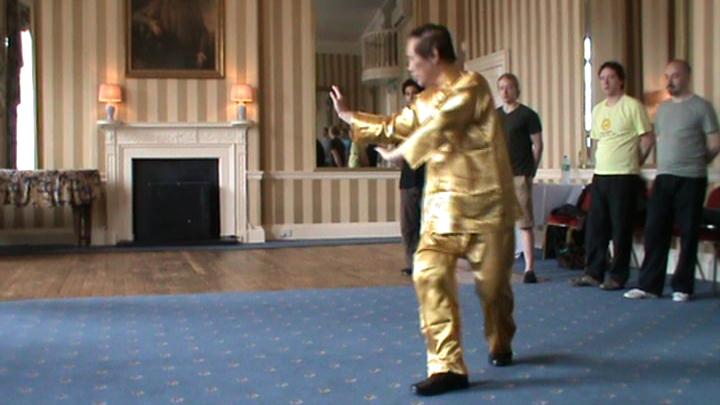
Grandmaster Wong demonstrating Baguazhang Circle Walking
-
The principles of palm techniques, they take the meaning of Eagle, they take the meaning of Snake. For every change of palm, from the beginning to completion, should be gentle and fast, completed in one breath, without any break. The whole technique is everywhere with mind, everywhere with meaning. There should not be expression of strength popping up or sinking down, thus missing the miracle of flow.
As the title of the classic suggests, it focuses on the internal aspect of Baguazhang. It explains that there are eight internal palms, and eight external palms. The eight internal palms represent the body of Baguazhang, the eight external palms represent its application and are full of variations.
The classic explains as follows:
-
The eight internal palms emphasize force. The miracle of combat is found here. The eight external palms emphasizes combat. They bring out the miracle of force. The arts of the internal and external eight palms are born from the mutual interaction and neutralization.
The eight internal palms are so-called not because they have no external forms but because they are meant to develop internal force. It is like what we did in the Baguazhang course at the UK Summer Camp of 2012, internal force training using various Baguazhang postures and circle walking.
The eight internal palms described in this classics are as follows:
- Floating Wood Palm -- the arms are held horizontally like in Lifting Water.
- Moving Clouds Palm -- the arms are held high like in Embracing the Sun.
- Spiral Turning Palm -- One arm is held at eye level and the other arm at shoulder level, like in Lion Opens Mouth.
- Up-Down Palm -- One hand held straight is pointing skyward, and the other hand also held straight is pointing downward, as in Point Sky Jab Ground.
- Embracing Clouds Palm -- Both arms are held as if holding a huge ball, like in Unicorn Embracing Moon.
- Thread-Shuttle Palm -- like in the pattern Jade Girl Threads Shuttle.
- Throw-Step Palm -- Moving as if performing Green Dragon Shoots Pearl
- Wind-Wheel Palm -- Start with holding a pearl, then push one hand out
The eight external palms are similar to the eight mother-palms we learned at the Baguazhang course for circle walking, as follows.
- Single Changing Palm.
- Double changing Palm.
- Smooth Posture Palm
- Triple-Thread Palm
- Back-Body Palm
- Circulate Body Palm
- Turn Body Palm
- Return Body Palm
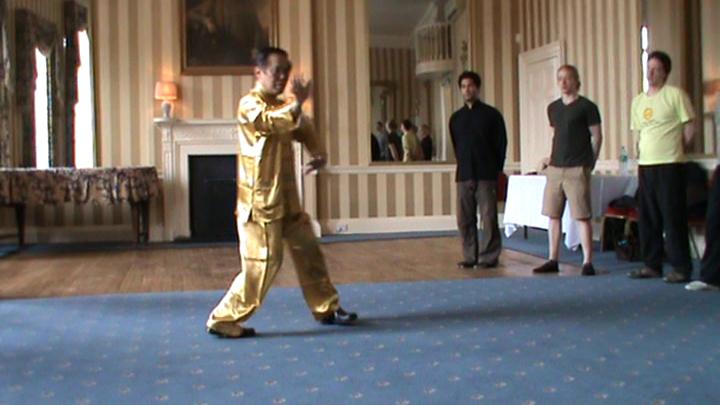
Grandmaster Wong demonstrating Baguazhang Circle Walking
It includes the Thirty Six Songs mentioned by Frederick. The first song translated from this classic is as follows:
-
Empty chest, lift head, sink the waist
Hook step, bend knees, grip the ground
Sink body, drop elbows, stretch front hand
Two eyes should emit from tiger's mouth
This song describes how the basic Baguazhang pattern, "Green Dragpm Tests Claw", should be performed. "Tiger's mouth" refers to that part of the palm between the thumb and the index finger.
There are two differences between what is advocated here and how we practice. We do not grip the ground with our toes; we let our chi flowing down to root us to the ground. Secondly, we need not look through the tiger's mouth. We do not even look at an opponent, but sense him with our all-pervading mind.
The advice above is given to beginners. Gripping the ground with their toes will make them more stable. Looking through the tiger's mouth will help them to focus.
We are at a more advanced level, even for those of our students who learn Bagauzhang the first time. We can let chi flow to the ground rooting us, which is not only more stable but also enable us to have unity of chi flow. We can expand our mind so that it covers not only an opponent's movements but also his intentions. Other practitioners do not have these abilities.
The book also lists other Baguazhang priniples, like "three hearts", "nine strengths", and "nine requirements".
The "three hearts" or three centres are the abdomen as the focused centre, the eyes as the sensing centre, the head as the function centre, and the hands and legs as the operating centre.
We have surpassed the above advice. Our whole being is one heart or one mind. Not only our abdomen is charged with chi, our whole being is charged with chi. We do not just sense with our eyes, function with our head and operate with our hands and legs, we can do all these with any part of our body.
The "nine strengths" are stretch-up strength, lift strength, sweeping strength, struggle strength, horizontal strength, spring strength, inside strength, turning strength and united strength. We also have surpassed these nine strengths. Our body is just one strength or one energy, which can be employed to perform work done by any one of these nine strengths and more.
The "nine requirements" are that the waist is to be lowered, that chi is to be sunk, that the anus has to be lifted, that the tongue is to touch the palate, that the elbows are to be in, that muscles and joints are to be relaxed, that the shoulders are to be dropped, that the body is to be retracted, and that the palms are to thread.
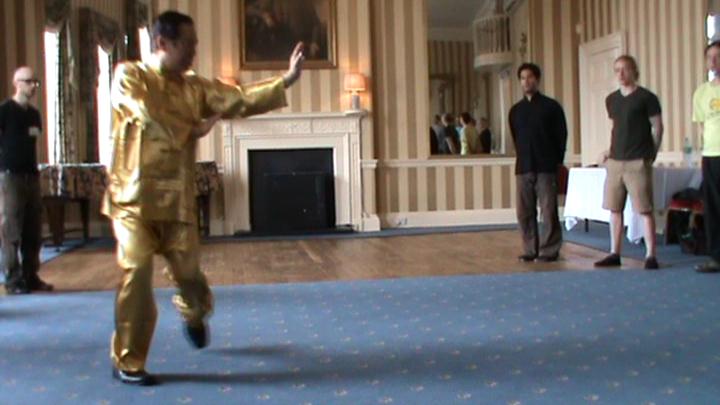
Grandmaster Wong demonstrating Baguazhang Circle Walking
Why don't we need to follow requirements that Baguazhang masters have advised practitioners to follow, yet we still obtain good or better results? It is because from our normal training we have surpassed the level the requirements purport to attain. For example, lifting the anus and placing the tongue at the palate are to facilitate chi flow, but we already have good chi flow even without these requirements.
We have often mentioned that we practice high-level arts. Even without following these requirements we can attain a level higher than what the requirements aim at. This confirms our claim.
Specific Techniques of Bagua is also a modern publication based on classical material. It explains the application of specific Baguazhang techniques against 64 combat situations.
There are some sophisticated techniques on kicks or using the leg to fell opponents. But unless one is advanced in combat applications or learns from a master, he may not realize the sophisticated techniques even when there are short descriptions. The verbal descriptions, as usual, are inadequate to explain clearly how the transitional movements are performed.
Even if he can follow the pictures and descriptions, he will still miss many important combat points, such as timing and spacing. The pictures and descriptions may indicate a practitioner to move a step forward, for example, but without proper guidance from a competent teacher, a student may not know when to move or where to place his feet, which will render his technique ineffective.
A very important point a student is likely to miss if he learns from the book without guidance from a competent teacher is that he will expose himself in his movements. The illustrations in the book are well done, showing that both exponents in combat cover themselves adequately, but an unsuspecting student is likely to expose his vital points to be exploited by his opponent if he has not been properly trained.
Besides these classical sources I also have a collection of photographs and hand-written explanation on the 64 applications of Baguazhang sent to me many years ago by a Baguazhang master. They show some interesting and sophisticated applications. But uninformed readers would not understand them because the photographs indicate established forms, transitional movements are not shown.
This shortcoming is overcome with videos, and there are a lot of videos on YouTube. The following are just some random samples.
Here is a good video (of a series of videos) showing basic Baguazhang Circle Walking by Sifu Kent Howard of Wang Shu Jin's lineage.
Here is a video showing more advanced Baguazhang Circle Walking by Sifu Sun Zhi Jun.
Baguazhang masters are known to be old yet healthy and agile. Have a treat watching Sifu Lu Zi Jian who was 118 years old performing double sabres, rolling about on the floor.
Here is a performance of Old Bagua Palms by Sifu Liu Jing Nu.
The 64 Palms of Baguazhang are linked together into a set known as Swimming Dragon Set. There are various versions of the set, and here is a video showing one of them.
Here is a video showing some Baguazhang applications.
Here is another video on Baguazhang applications.
Baguazhang performed as wushu is beautiful to watch, though it may not be effective for combat. Here is a beautiful demonstration of Wushu Baguazhang.
Here are some Baguazhang sparring sets. It is obvious that they are performed as routines rather than for combat training. The video also shows some interesting specific techniques.
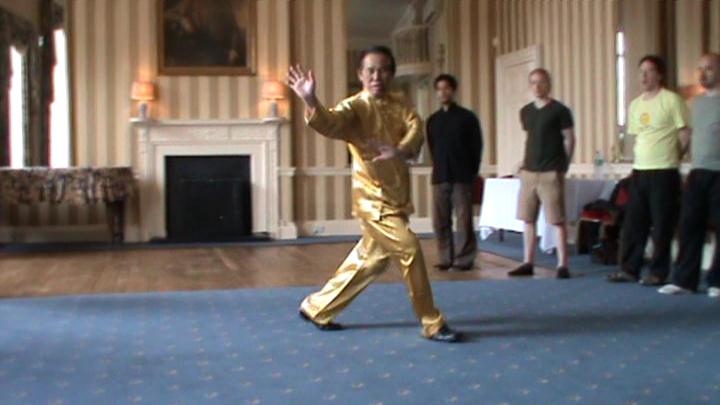
Grandmaster Wong demonstrating Baguazhang Circle Walking
Please note that there are two approaches here. One is from patterns to situations, i.e. we find out how Baguazhang patterns are used for combat. The other is from situations to patterns, i.e. if we are in a certain combat situation, how we can effectively handle it using an appropriate pattern.
Having a philosophical understanding, we can then put the patterns or the situations into practical use. A good way is to break up a sparring set into sequences, and practice them. Then further break up a sequence into smaller parts. Go over the parts in routine. Then practice the parts at random.
The questions and answers are reproduced from the thread 10 Questions to Grandmaster Wong -- Baguazhang (Pakua Kungfu) in the Shaolin Wahnam Discussion Forum.
LINKS
